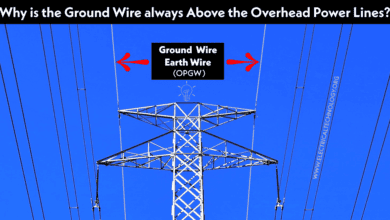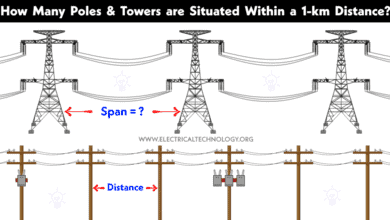What Happens if a 50Hz Transformer is Connected to 5Hz or 500Hz Supply Frequency?
What would happen if a power transformer designed for operation on 50Hz frequency were connected to a 5 Hz frequency or 500Hz source of the same voltage?
Power transformer is made to operate on specific frequency, usually 50Hz or 60Hz. Let’s see what happens if a 60Hz or 50Hz transformer is connected to the 5Hz and 500Hz frequency then.
Transformer Rating & Parameters
Suppose, a transformer rating as follow where the rated frequency is 50Hz.
- V = Voltage = 11kV
- R = Resistance = 100Ω
- L = Inductance = 0.3 Henry
- f = Frequency = 5Hz, 50Hz & 500Hz
Related Post: Which Transformer is More Efficient When Operates on 50Hz or 60Hz?
50 Hz Transformer Operated on rated 50Hz
We can find the transformer primary current by I = V/Z (Ohm’s Law i.e. I = V/R) where the Z is the impedance (resistance of AC circuits) which further depends on inductive reactance (XL).
To calculate the circuit impedance, we will have to find the inductive reactance first.
Inductive Reactance = XL = 2πfL = 2 x 3.1415 x 50 x 0.3
XL = 94.2Ω
and
Impedance Z = √ (R2+XL2)
Z = √ (1002+94.2 2)
Z = 137.4 Ω
The current in the transformer primary
I = 11kV / 137.4 Ω
I = 80 A
Now, Power of the circuit
P = V x I x Cos θ …. (i.e. P ∝ I in this case)
Current is directly proportional to the current.
Power factor = Cos θ = R/Z
Cos θ = 100 Ω / 137.4 Ω
Cos θ = 0.73
P = V x I x Cos θ
P = 11kV x 80A x 0.73
P = 642.4kW
I.e. The rated Power is appropriate when transformer is operated on the rated frequency of 50Hz.
50 Hz Transformer Operated on 5Hz
If the frequency is too low, primary will have insufficient reactance and too much primary current will flow, producing considerable copper losses (P = I2R). The transformer may start to smoke and burn with blast leading to dangerous fire.
Transformer with same rating is connected to the 5Hz supply source. We will do the same calculation to find the current in case of lower frequency than rated frequency of 50Hz.
Inductive Reactance = XL = 2πfL = 2 x 3.1415 x 5 x 0.3
XL = 9.42 Ω
and
Impedance Z = √ (R2+XL2)
Z = √ (1002+9.422)
Z = 100.44 Ω
The current in the transformer primary
I = 11kV / 100.44 Ω
I = 109.52 A
Power factor = Cos θ = R/Z
Cos θ = 100 Ω / 100.44 Ω
Cos θ = 0.9
P = V x I x Cos θ
P = 11kV x 109.52 x 0.9
P = 1084kW
The power is much more than the rated power of the transformer due to high current, high magnetizing current and more power flux. This will cause insulation losses and transformer may stat to smoke due to low inductive reactance to oppose the flow of large current.
Related Post: Why Transformer Does not Work on DC Supply instead of AC?
50 Hz Transformer Operated on 500Hz
If the frequency is too much high as compared to the rated frequency, the inductive reactance of the primary will prevent the primary from drawing sufficient power. The hysteresis losses and eddy current losses will be excessive.
The same transformer is connected to the 500Hz frequency supply. Let’s do the same calculation as above to find the current in case of higher frequency.
Inductive Reactance = XL = 2πfL = 2 x 3.1415 x 500 x 0.3
XL = 942.4 Ω
and
Impedance Z = √ (R2+XL2)
Z = √ (1002+942.42)
Z = 947.7 Ω
The current in the transformer primary
I = 11kV / 947.7 Ω
I = 11.6 A
Power factor = Cos θ = R/Z
Cos θ = 100 Ω / 947.7 Ω
Cos θ = 0.1
P = V x I x Cos θ
P = 11kV x 11.6A x 0.1
P = 12.76kW
The amount of transferred power is too much low as compared to the rated power in case of higher frequency of 500Hz.
As mentioned above, when current is reduced through high inductive reactance (due to high frequency where XL = 2πfL), power will be reduced because current is directly proportional to the power. In addition, eddy current and hysteresis losses will be excessive.
The reason behind this story is that:
I = V/Z
Where
Z = √ (R2+XL2)
But
XL = 2πfL i.e. XL ∝ f
i.e.
XL ∝ 1/I
And P ∝ I
and
ΦMax ∝ V and I. … (ΦMax = – VM / ωNP)
Related Posts:
- Why Current Increases When Capacitance Increases or Capacitive Reactance Decreases?
- Why Current Decreases When Inductance or Inductive Reactance Increases?
- In a Capacitive Circuit, Why the Current Increases When Frequency Increases?
- In an Inductive Circuit, Why the Current Increases When Frequency Decreases?
- Why Power Factor Decreases When Inductance or Inductive Reactance Increases?
- Why Power Factor Decreases When Capacitive Reactance Increases or Capacitance Decreases?

 What is the Power Angle in a Power Transmission Line?
What is the Power Angle in a Power Transmission Line? Why is the Ground Wire Always Positioned Above the Overhead Power Lines?
Why is the Ground Wire Always Positioned Above the Overhead Power Lines? What is the Minimum Ground Clearance for Overhead Power Line?
What is the Minimum Ground Clearance for Overhead Power Line? How Many Poles and Towers are Situated Within a 1-km Span?
How Many Poles and Towers are Situated Within a 1-km Span? Why are Overhead Power Transmission Lines Not Insulated?
Why are Overhead Power Transmission Lines Not Insulated? Why are “High Voltage” Signs used when Only Current Kills?
Why are “High Voltage” Signs used when Only Current Kills?